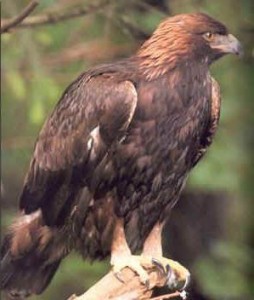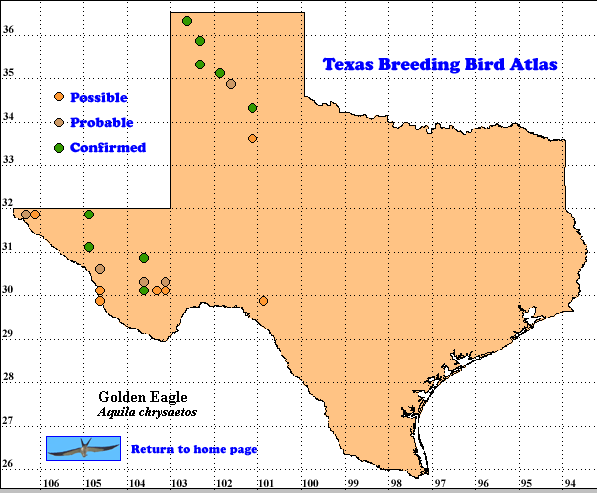The Golden Eagle, the only North American representative of the primarily Old World genus Aquila, is an impressive raptor, most common in the west from the arctic to central Mexico. New and Old World populations of this hawk are currently considered conspecific. In the Old World this species is found from the Atlantic Ocean east to Japan and south to the Himalayas, the Near East and North Africa. The ranges of others of the 10 species of this genus overlap with that of the Golden Eagle or extend south in Africa, and into India, south Asia, Indonesia and Australia (Monroe and Sibley 1993, Am. Ornithol.Union 1998).
Unfortunately a predator of the Golden Eagle’s size too often attracts shooting, trapping or poisoning by humans sure these birds are a threat to livestock or people. Actually these hawks primarily prey on rabbits, especially black-tailed jackrabbits, hares, ground squirrels and prairie-dogs. Golden Eagles require a large foraging area with a safe nesting site, inaccessible to predators. Year-round resident eagles in states such as Texas, usually defend their territories throughout their long lifespans (up to 24 years in North America; Kochert et al. 2002).
DISTRIBUTION. During the 1987-1992 field work seasons of the TBBA project, investigators found confirmed breeding sites for Golden Eagles in the Panhandle at latilong-quads 36102-D2, 35102-C4 and G4, 35101-A7 and 34101-D1; a probable at 34101-H6 and possibles at 35107-H7 and 33101-F2. In the Trans-Pecos confirmed breeding was found in 30103-A5 and H6, probable breeding in 31106-H4, 31104-G7 and H7, 30104-E6 and 30103-D2 and D6 and possible sites in 31106-H1, 31104-H7 and H8, 30104-A5 and E5, 30103-A3 and B2 and 29104-H5. A final possible is further east at 29100-H8. Probably due to the remote location of many breeding sites, Breeding Bird Survey (BBS) observers only found Golden Eagles in the Davis Mountains area (Sauer et al. 2007)..
In North America, migratory populations of this species breed in Alaska and across Canada. Resident populations are found in southwest Canada and the western United States east to the western Great Plains and south to northern Baja California and through the highlands of Mexico south to the central volcanic belt. Migrants winter throughout the resident area, in scattered locations of the United States east of the breeding area and in northwest Mexico (Howell and Webb 1995, Kochert et al. 2002, .Lockwood and Freeman 2004).
SEASONAL OCCURRENCE. Golden Eagles are resident in Texas and breed from early February to November, based on egg dates from February 16 to October 11. Winter visitors are present from late August to late April, most in Texas from early October to mid-March (Oberholser 1974).
BREEDING HABITAT. Golden Eagles breed in Texas as high as 2600 m (8600 ft) in mountains and canyons (Oberholser 1974). In Oklahoma this species only breeds in Cimmaron County where cliffs are present in sparsely populated, semi-desert short-grass prairie (Jenkins 2004). In Colorado most breeding activity was found in the mountains and the rugged southeast with 3/4 of sites roughly evenly split between woodlands and cliffs and similar situations and the other sites found in shrubland (~14%) and grassland (~11%) habitats (Barrett 1998). In Arizona breeding was widely distributed in the state at elevations ranging from low mountains in the southwest corner of the state at about 400 m (1300 ft) to near 2700 m (9000 ft) in the state’s higher mountains. Above this elevation, greater forest density apparently discourages these large birds. Specific habitats covered a broad range with pinyon-juniper (21%) and Sonoran desert scrub (15%) being the most common (Driscoll 2005).
Nests are usually placed in remote areas on cliffs, in trees or on unused strictures. Territories are usually large, as much as 200 km2 (75 mi2). Nests are built by both sexes from sticks, roots, stems, and human debris and lined with grass, forbs, live or dead leaves and moss. They are often refurbished and enlarged in successive or alternate years and may reach diameters of 2 m (>6 ft; Kochert et al. 2002).
The female usually lays 2 (range 1-4) rough, white to cream-buff eggs, variously marked, at 2-3 day intervals. Incubation, mostly by the female,. starts after the first egg is laid and lasts about 31-34 days. Young birds leave the nest 45-81 days after hatching and remain with their parents for another 1-6 months (longer for resident populations). Golden Eagles generally start breeding after acquiring adult plumage at 5 years of age (Harrison 1979, Kochert et al. 2002).
STATUS. Golden Eagles are rare to locally uncommon in their range in west Texas (Lockwood and Freeman 2004). They apparently no longer reside at nesting sites on the Rolling Plains and Edwards Plateau shown on Oberholser’s 1974 map. BBS data for Texas are inadequate to provide a biologically meaningful population trend for this state, but data from 327 routes in North America provide a statistically significant annual population change of +2.9% for the period 1980-2006 (Sauer et al. 2007).
Text by Robert C. Tweit (2007)
Literature cited.
American Ornithologists’ Union. 1998. Checklist of North American birds, 7th ed. Am, Ornithol. Union, Washington, DC.
Barrett, N. M. 1998. Golden Eagle (Aquila chrysaetos). In Colorado Breeding Bird Atlas, pp. 124-125 (H. E. Kingery, ed.), Colorado Bird Atlas Partnership, Denver.
Driscoll, J. T. 2005. Golden Eagle (Aquila chrysaetos). In Arizona Breeding Bird Atlas. pp. 150-151 (T. E. Corman and C. Wise-Gervais, eds.), University of New Mexico Press, Albuquerque.
Harrison, H. H. 1979. A field guide to western birds’ nests. Houghton Mifflin, Boston, MA.
Howell, S. N. G. and S. Webb. 1995. A guide to the birds of Mexico and northern Central America. Oxford University Press, New York.
Jenkins, M. A. 2004. Golden Eagle (Aquila chrysaetos). In Oklahoma Breeding Bird Atlas, pp. 106-107 (D. L. Reinking, ed.). University of Oklahoma Press, Norman.
Kochert, M. N., K. Steenhof, C. L. McIntyre and E. H. Craig. 2002. Golden Eagle (Aquila chrysaetos). InThe Birds of North America, No. 684 (A. Poole and F. Gill, eds.). The Birds of North America, Inc., Philadelphia, PA.
Lockwood, M. W. and B. Freeman. 2004. The TOS handbook of Texas birds. Texas A&M University Press, College Station.
Monroe, B. L., Jr. and C. G. Sibley. 1993. A world checklist of birds. Yale University Press, New Haven, CT.
Oberholser, H. C. 1974. The bird life of Texas, University of Texas Press, Austin.
Sauer, J. R., J. E. Hines, and J. Fallon. 2007. The North American Breeding Bird Survey, results and analysis 1966-2006. Version 7.23.2007. USGS Patuxent Wildlife Research Center, Laurel MD < http://www.mbr-pwrc.usgs.gov/bbs>

